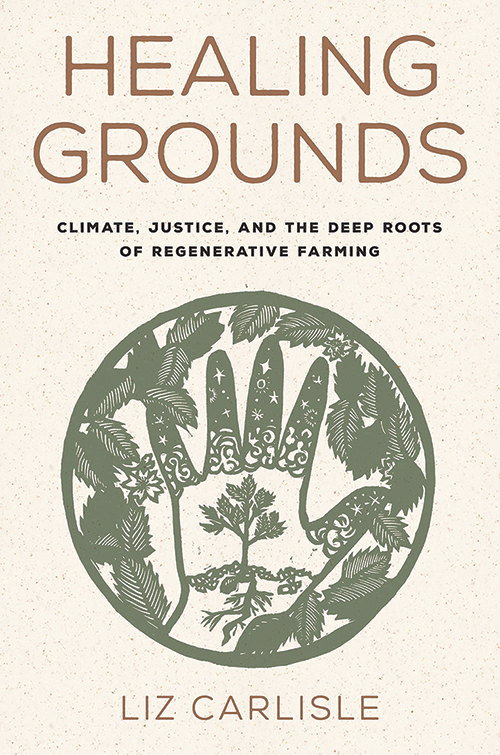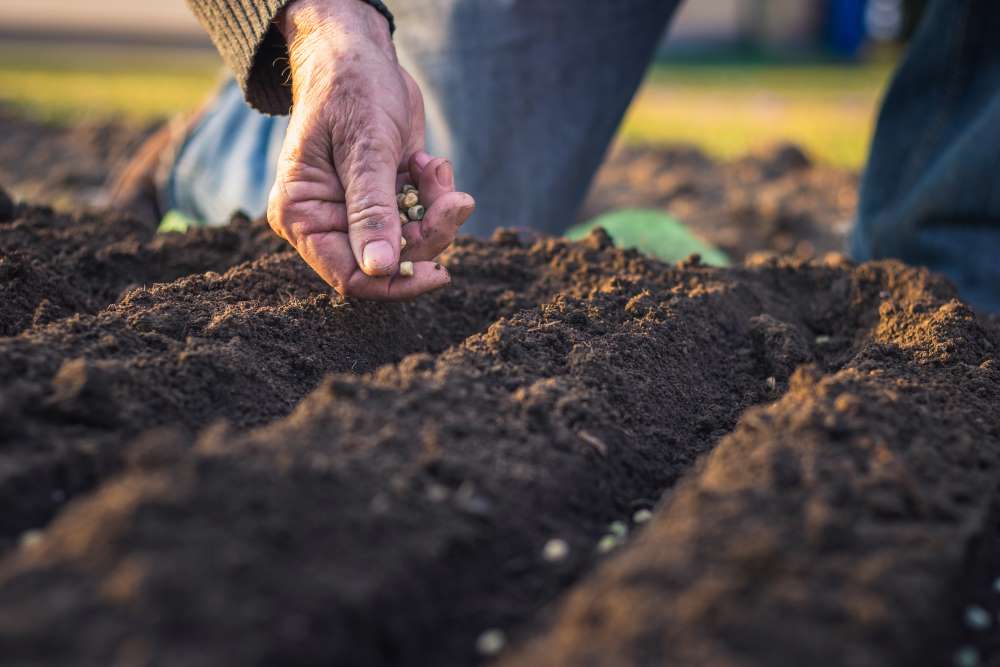
Healing Grounds: Climate, Justice, and the Deep Roots of Regenerative Farming
Reviewed by Pamela Haines
March 1, 2023
By Liz Carlisle. Island Press, 2022. 200 pages. $28/hardcover; $27.99/eBook.
The starting point of Healing Grounds, that regenerative agriculture is good for the soil and for the climate, is familiar to me and rings true. Consider the vast capacity of our soils to store carbon—currently three times more than the amount in the atmosphere—along with the fact that industrially farmed monocultures are the major cause limiting that capacity. What was fresh for me, and what gives this book its great strength, is the author’s emphasis on the people who tend the soil.
Many of us have some understanding that the traditions and wisdom of Indigenous groups throughout the world have much to teach industrialized countries. We may also be aware of critiques of the industrial agricultural model in this country, and of movements to think in fresh ways about farming and grazing methods and our relationship with the soil. But this book goes farther, throwing open a window on the Indigenous practices that are flourishing within our borders and the challenges facing the communities of people who practice them, whose well-being we threaten at our common peril.
The author discusses four communities: Indigenous North Americans, African Americans, and Mexican and Asian immigrants. Centering each section on the stories of particular individuals, while weaving in related current efforts and historical background, makes for a very accessible read that’s full of new information and surprising connections.
Who knew that Haudenosaunee (Iroquois) “corn growers produced three to five times as much grain per acre as European wheat farmers in the same time period”? More broadly, we see that forward-looking agricultural practices like no-till farming and regenerative grazing just scratch the surface. We are called to not only listen to the voices of Indigenous people and learn from species like the buffalo, but consider how we can participate in an interdependent web of life. Or we can become the broken link that prevents everything else from working in concert.
Turning to the African American experience, we face the staggering costs of 98 percent of Black agricultural landowners becoming dispossessed between 1915 and 1995, and learn that George Washington Carver was the first U.S. scientist to reject industrial farming for regenerative, organic agriculture. This section centers around a young Black woman who brought her farming experience to a family wood lot in North Carolina. She was unwilling to have that bit of her heritage sold-off and equally unwilling to clear-cut for more traditional agriculture. A history of agroforestry in Africa, as well as the tradition of intensively productive dooryard gardens during slavery, offer examples of biodiversity disrupting the sea of commodity monoculture that is the mainstay of colonial and slave-based agriculture.
A soil scientist from a Mexican immigrant family in California’s Central Valley anchors the next story. While a third of U.S. produce is grown in the valley’s massive industrial monocultures, 2,000 small farmers on less than 1 percent of its acreage are the ones bringing the land back to life. They support the microscopic fungi that have been in symbiotic relationship with plant roots for 500 million years and are threatened in soils that have been repeatedly disturbed, poisoned, and left bare. Mexican polyculture farming, more productive per acre than any monoculture, has been key to creating hot spots of biodiversity that are critical to soil, plant, and human health.
Finally, two small farmers of Hmong and Japanese ancestry illuminate the role of Asian immigrants, highlighting the traditions of recycling nutrients in closed-loop systems that have made Asia such a source of inspiration for the organic movement. Yet, as with the Mexicans, coming as farmworkers with hopes to become farmers, they face formidable obstacles to citizenship and landownership.
The lessons are painfully clear. This stark inequality in agricultural landownership is not only unjust, it is also blocking our access to a heritage of regenerative agriculture practices that we desperately need to combat climate change. The extraction of carbon from soils is just one integral piece of a much larger process of extraction that lies at the heart of our continent’s history, including theft of land, enslavement of human beings, and extortion of labor. The vital work of rebuilding soil carbon is inextricably woven together with the vital work of racial justice. To repair the soil, the author contends, we need to repair it all.
For Friends who care about race and justice, and for those who care about climate, this book is a testament to how closely they are intertwined.
Pamela Haines is a member of Central Philadelphia (Pa.) Meeting. Author of Money and Soul, her newest titles are That Clear and Certain Sound and a second volume of poetry, Encounters with the Sacred and the Profane. She blogs at pamelahaines.substack.com.
1 thought on “Healing Grounds: Climate, Justice, and the Deep Roots of Regenerative Farming”
Leave a Reply
Comments on Friendsjournal.org may be used in the Forum of the print magazine and may be edited for length and clarity.



It’s great to know all of this. However, the general economic part of farm justice has been left out of the story. With good prices (100% of parity,) 1910-1919, the number of black farmers (nonwhite farmers in the South,) rose to it’s highest level. It fell with the 1920s farm depression and Great Depression. The parity-level farm programs of 1942-52 led to a 12% increase in nonwhite farm owners in the South, (about 98% black, 1940 NASS Census of Ag vs 1950). With minimum Price Floors for Cotton and other crops reduced, more and more, 1953-1995, however, the rate of loss of black farmers greatly increased. This is really only understood by knowing of the massive, increased losses, also, of white farmers. Price floors were ended in 1996. It’s a poor solution to put new minority farmers into a situation where most experienced farmers were run off. It’s a way to lose wealth. So we must restore just Price Floor programs, (as black farmers have repeatedly emphasized,) not just address racism in the many places it shows up to hurt minority farmers, and in the legacy it has passed on to surviving minority farmers, (smaller farms on poorer quality land). Read/see them in “Ensure that farmers receive a fair living wage” and “From the Grassroots Up, Not from the Money Down.”